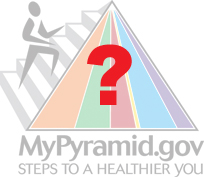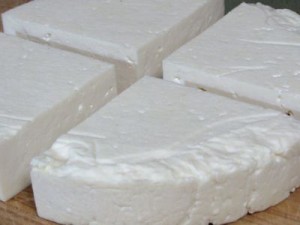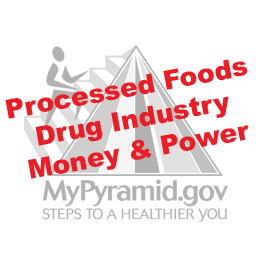
The kids and I bought (and ate) commercial yogurt yesterday while we were out. It was a compromise food, in my opinion. As in, even though it contained active cultures, the milk was factory-farmed, pasteurized, and lowfat, and the yogurt contained lots of sugar, among other questionable ingredients. In my somewhat drained and hurried state I was okay buying and eating it. It fit the bill and was the best I could do under the circumstances.
The kids and I were happily opening our yogurt containers in carefully chosen flavors (mine was cherry vanilla). C. looked at his container, read the “lowfat” label, and then said expectantly, “Mom? Is it really lowfat?” He sounded pleased. He knows that manufacturers add labels only for the “good” things. If it was labeled, it must be a good thing.
Me: Yes, it is lowfat.
C.: That’s good, right?
Me: Let me ask you something, C.. God gave us milk to drink, right?
C.: Yes.
Me: The Bible talks of drinking milk, doesn’t it? “And thou shalt have goats’ milk enough for thy food…” Proverbs 27:27
C.: Yes…
Me: When the milk comes out of a goat or a cow, do you think it is lowfat?
C.: No, it has all its fat! (Good boy.)
Me: So what do you think God’s design is for milk – lowfat or with all its fat?
C.: Oh. Definitely with its fat. (Another point for C.!)
Yes, yes, yes. The Creator’s stamp of approval right there. Very simple. Lowfat is not seen in nature. Or at least, not very often; some meats are naturally lean.
An Unnatural Approach

Have you seen the (draft) 2010 USDA Dietary Guidelines? Here’s a summary of the recommendations:
- more stringent restriction of saturated fat (7 percent of total calories, down from 10 percent)
- recommends keeping cholesterol consumption to less than 300 mg per day (but at less than 200 mg per day for those with risk factors for heart disease or diabetes)
- recommends reduction of salt intake from 2.3 grams to 1.5 grams (about one-fourth teaspoon)
- lumps trans-fats with saturated fats, using the term “solid fats” for both
- promotes an increase in difficult-to-digest whole grains
- recommends lean meats and lowfat dairy products; cheese is specifically singled out for avoidance because of its high “solid fat” content
What is wrong with all these? Well….
We need saturated fat.
“Basic biochemistry shows that the human body has a very high requirement for saturated fats in all cell membranes; if we do not eat saturated fats, the body will simply make them from carbohydrates. But excess carbohydrate increases blood levels of triglyceride and small, dense LDL, and compromises blood vessel function. Moreover, high-carbohydrate diets do not satisfy the appetite as well as diets rich in traditional fats, leading to higher caloric intakes and often to bingeing and splurging on empty foods, resulting in rapid weight gain and chronic disease.” —Weston A. Price Foundation email on 6/23/2010
More on why we need saturated fats.
Cholesterol does not cause heart disease (nor does saturated fat).
Cholesterol is like the fire engine that comes to put out a fire. In other words, it is our bodies’ solution to a complex problem.
More about cholesterol and heart disease.
We need salt.
“Salt is essential to life, that is why we have salt taste buds. Without salt, we die. We need salt for protein digestion, carbohydrate digestion, adrenal function, cellular metabolism and brain development. Unrefined salt provides us with many trace minerals.” —Miscellaneous Food FAQs, Weston A. Price Foundation.

Trans-fats are different than saturated fats.
“The Guidelines lump trans fats together with saturated fats — calling them Solid Fats — thereby hiding the difference between unhealthy industrial trans-fats and healthy traditional saturated fats. Trans fats contribute to inflammation, depress the immune system, interfere with hormone production, and set up pathological conditions leading to cancer and heart disease, whereas saturated fats fight inflammation, support the immune system, support hormone production and protect against cancer and heart disease.” —Weston A. Price Foundation email on 6/23/2010
More info: Know Your Fats.
Whole grains should be properly prepared and consumed with fat.
“The Guidelines promote the consumption of whole grains, which can contribute to digestive disorders unless properly prepared. The Guidelines completely avoid mentioning blood sugar problems caused by a diet high in carbohydrates and low in fat; the diet is particularly dangerous for those suffering from diabetes or hypoglycemia, since fats help regulate blood sugar levels. Many people have difficulty concentrating or can even suffer from seizures on a diet too low in fat.” —Weston A. Price Foundation email on 6/23/2010
More on why and how to properly prepare whole grains.
We need fatty foods such as egg yolks, butter, whole milk, cheese, and fatty meats.
“The current obesity epidemic emerged as vegetable oils and refined carbohydrates replaced healthy, nutrient-dense traditional fats. Animal fats supply many essential nutrients that are difficult to obtain from other sources.
The proposed guidelines will perpetuate existing nutrient deficiencies present in all American population groups, including deficiencies in vitamins A and D found in animal fats, vitamins B12 and B6 found in animal foods, as well as minerals like calcium and phosphorus, which require vitamins A and D for assimilation. Moreover, low intakes of vitamin K2, are associated with increased risk of heart disease and cancer. The main sources of vitamin K2 available to Americans are egg yolks and full-fat cheese.
The vitamins and fatty acids carried uniquely in saturated animal fats are critical to reproduction. The 2010 Guidelines will increase infertility in this country, already at tragically high rates.
By restricting healthy animal fats in school lunches and diets for pregnant women and growing children, the Guidelines will perpetuate the tragic epidemic of learning and behavior disorders. The nutrients found most abundantly in animal fats and organ meats-including choline, cholesterol and arachidonic acid-are critical for the development of the brain and the function of receptors that modulate thinking and behavior. Studies show that choline helps the brain make critical connections and protects against neurotoxins; animal studies suggest that if choline is abundant during developmental years, the individual is protected for life from developmental decline.” —Weston A. Price Foundation email on 6/23/2010
(Please note: if on a Levitical or kosher diet, plenty of saturated fatty acids can be consumed even without fat from animal meat.)
Take a look back at those headings of food components we need or distinctions that must be made. Saturated fat (not trans fats), cholesterol, salt, properly prepared whole grains, and fatty foods. Those are the unadulterated real foods or food components of history and tradition.
Imagine.
Our forefathers would milk a goat or cow. Yield: raw, sweet, fresh, whole milk. Lowfat? No!
Cow’s milk cream would rise to the top. They’d skim it (leaving fat behind in the milk, mind you). Then they’d churn fresh or cultured butter. Would this delectable, God-given butter be wasted or tossed? Never!
A chicken would be raised on pasture, scattered seeds, and bugs. Its eggs would would nourish many a hungry stomach over the months. When butchered, its lean breasts would be eaten, as well as the fatty thighs (waste not, want not). Drippings would be used to fry bread, pan cakes, or vegetables. Bones were slow simmered in the stockpot for a nutritious, flavorful stock, grease and all.
According to the USDA, we are not to eat these foods designed and given by our Creator. Now, the USDA committee members might not believe in God. But whether or not they credit God with nature’s design, how can they think that guidelines which are contrary to the natural world make any sense?

What Guides The USDA?
Clearly, the health-giving properties of nutrient-dense natural foods do not influence the USDA. So, what does guide them? Two additional questions reveal a startling answer.
1. What is left for us to eat, if not the nutrient-dense foods of nature? Processed foods.
2. Who or what does the USDA dietary guidelines committee represent? Seven of the 13 members have ties to the food processing industry and the drug industry. (Source.)
Now it makes sense. When the committee leads people to believe that the nourishing foods of thousands of years are bad for health, the people will buy more processed foods. Modern diseases and poor health will increase, and people will rely even more heavily on pharmaceutical drugs.
Money and power. Money and control. Money. Power. Control.
The guidelines are absolutely not about our health. Don’t buy into it. Get back to the nutritious foods of history like eggs, butter, whole milk, cheese, and fatty meats.
The world needs to know the truth. We can turn this around if we refuse to follow along.
Please, Take Action Today
First, click here to grab a PDF of the Weston A. Price email, dated 6/23/2010, which has much more detail than my post today. It contains their summary, a list of talking points (use any of them for a blog post of your own), suggested action steps, and a press release to share with local newspapers and radio stations.
Next, the following action steps are highly recommended by the Weston A. Price Foundation. Please do as many as you can! (These are also outlined in the email download.)
- ASAP, post a comment at the USDA website. Go to www.dietaryguidelines.gov and scroll down to “SUBMIT Written Comments.” It is particularly important to describe any adverse health effects you or family members have suffered by following earlier versions of the Guidelines. You may also want to use any of the talking points listed in the Weston A. Price email.
- Also, EMAIL your comments (from step 1) to your Senators and Representative in Congress. Let them know that USDA’s formulation of dietary guidelines is a complete waste of taxpayer money and has resulted in a health crisis of epidemic proportions, especially in our children. It would also be good also to PHONE your elected officials as well. For congressional contact information, go to www.house.gov and www.senate.gov.
- If you live near Washington, DC, consider attending the public hearings at USDA on July 8, 2010. You can sign up to give an oral presentation (as WAPF will do) or simply attend to show support. To sign up for attending the meeting, go to www.dietaryguidelines.gov and scroll down to “Meeting Registration/Oral Testimony.”
- Please send out the Press Release (download here) to your local newspaper and radio shows. You may add your own contact information to that of our publicist Kimberly Hartke. In addition, you may add a paragraph to the press release about how the USDA dietary guidelines adversely affected your own health and that of your family.
- Please broadcast this action alert to other groups, such as sharing on your blog or website. Let’s create a tidal wave of outrage!
Let’s get the word out that we will not be brainwashed into believing the lies that are spread by the processed food industry via “objective” USDA committee members. Leave a comment below with your thoughts or additional suggestions of what can be done. Also, please let me know what action steps you’ve taken. If you share what you’re doing, it will inspire others to do the same.
I have submitted a written comment on the USDA’s dietary guidelines website. I have emailed my senators. I have emailed my representative. I have submitted the press release to two local newspapers. Anyone else?
We only recommend products and services we wholeheartedly endorse. This post may contain special links through which we earn a small commission if you make a purchase (though your price is the same).



thank you for this post! i’ve been learning so much in the past two years on this topic but i haven’t known what to DO about it. i mean, other than changing our diets. that was the first thing. but now i want to share this information with others and i’d love to make a difference somehow. it’s so frustrating to hear people say something about butter being bad or all the other things you hear that just simply aren’t true. thank you for the links to USDA’s website. i have much to share with them!
Thank you for speaking up and sharing your thoughts, Stacey! God bless you.
Wonderful post that spells out my feelings exactly. I also find it interesting that, when God told his people of the promised land, it was a land “flowing with milk and honey”. Just another reinforcement: God wouldn’t have promised them that if their milk (full fat & raw) was not a blessing to them!
Lisa – That verse often comes to my mind — such an encouragement. Thank you for pointing out that milk is a blessing, not just a food!
Knowledge is power, so SHARE that knowledge any way YOU can and make a difference in our world!
Wardee, thanks so much for this post. I just posted a comment on the USDA Guidelines website. Here it is:
The USDA should be applauded for their desire to see Americans eat healthier diets and get more exercise in their daily routine. An awareness of the current diet of children and their lack of exercise is critical to this country, and especially for parents to see because they may very well be modeling for their children the negative dietary habits that may affect them the rest of their lives. However, looking at these guidelines leads one to think that the only healthy way to eat is to eat processed food. Does it not make more sense to study the patterns of traditional healthy people groups from ages past who did not have the health problems our country has now? My grandparents raised all their food and fed their 9 children a diet of beef, pork, and chicken with all the fat included, full-fat raw milk that was also used to make butter and buttermilk, salt-cured meats, fresh vegetables, wholesome sweeteners like honey and molasses that were produced on the farm, and more. The only processed foods they brought into their home was white flour and an occasional treat of candy at holidays. They lived to be in their upper 80’s. My father died last year at 90. Maybe the best guideline for our youth, elderly, and everyone in-between is to eliminate processed food altogether and learn how to cook and eat traditionally prepared foods.
Hi Wardee
Could you share with us what supplements do you give to your kids?
Where I am, I do not have access to raw milk, butter and cheese and the prices of pastured meat and eggs are way, way too expensive. The only thing I can do is to provide my kids with whole grains and beans. That’s why I am thinking that I should also add supplements to their diet. Would really be grateful if you could share what are good supplements to give the kids (aged 7 to 12) and which brand would you suggest in your opinion.
Tks a million!
AA — Sorry I missed your question!
I only give fermented cod liver oil/butter oil to my kids. We get TONS of probiotics in each meal and snacks. I believe with a good, nutrient-dense, probiotic rich diet that only supplementation with the fermented cod liver oil/butter oil is helpful.
I love the title you chose, because someone might type into a search engine “USDA Dietary Guidelines 2010”, and find your post and learn about health.
Do you have a “GNOWFGLINS Dietary Guideline” similar to the food pyramid? I am trying to change our diet over to real, whole foods and am reading everything I can get my hands on, but I am having trouble actually putting it all into practice. I sit down and try to menu plan and end up just confusing myself. Does it matter how many servings of grains, proteins, fruits, vegetables, etc. as long as they are nutrient dense and prepared in a healthful way? I guess I’m looking for a general starting point for meal planning. Any help you can give me would be greatly appreciated!!!